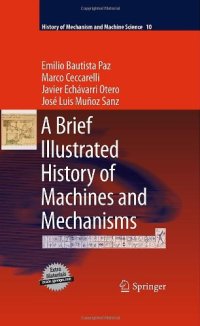
Ebook: A Brief Illustrated History of Machines and Mechanisms
- Tags: Engineering Design, Machinery and Machine Elements, Archaeology, History of Science, Mechanical Engineering
- Series: History of Mechanism and Machine Science 10
- Year: 2010
- Publisher: Springer Netherlands
- Edition: 1
- Language: English
- pdf
This book illustrates the historical development of machines and mechanisms more from a technical point of view rather than a strictly history of science point of view since the authors are mechanical engineers who are interested and motivated to examine the most significant facts in their own area of knowledge of the Theory of Machines and Mechanisms. A full understanding of the historical development of technology also needs the help of experts in technical matters who can appreciate and reassess bygone achievements in the light of their own technical knowledge. More collaboration between science historians and technical experts is needed, as is currently the case in the field of Industrial Archaeology. Thus, this book is also an attempt to set out a technical approach to the historical development of machines and mechanisms, with enough technical detail to prevent its understanding being purely historical.
This work deals with mechanical manufacturing processes in history, examined through the machines associated with those processes. A tool is only included if it is part of a machine tool, with devices made up of moving parts. The chosen descriptive method is basically graphic.
At the beginning of each chapter there is a global reference to the period embraced, the most relevant facts, and the most significant treatises in the context of machine history. Following this introduction each chapter contains a series of sections on the types of machines that are representative of the period analysed together with illustrations to accompany the text. A fairly extensive bibliography enables the reader to pursue their own further research and historical analysis.
Indexed in the Book Citation Index– Science (BKCI-S)
Review From the reviews: “This work by mechanical engineers Bautista Paz … and colleagues provides a very short historical overview of machines. … It covers much mechanical engineering history, and if one wants to get an idea of the breadth and depth of the field, then this volume will do the job. … Summing Up: Recommended. Lower-division undergraduates.” (A. M. Strauss, Choice, Vol. 48 (3), November, 2010) From the Back Cover This book illustrates the historical development of machines and mechanisms more from a technical point of view rather than a strictly history of science point of view since the authors are mechanical engineers who are interested and motivated to examine the most significant facts in their own area of knowledge of the Theory of Machines and Mechanisms. A full understanding of the historical development of technology also needs the help of experts in technical matters who can appreciate and reassess bygone achievements in the light of their own technical knowledge. More collaboration between science historians and technical experts is needed, as is currently the case in the field of Industrial Archaeology. Thus, this book is also an attempt to set out a technical approach to the historical development of machines and mechanisms, with enough technical detail to prevent its understanding being purely historical. This work deals with mechanical manufacturing processes in history, examined through the machines associated with those processes. A tool is only included if it is part of a machine tool, with devices made up of moving parts. The chosen descriptive method is basically graphic. At the beginning of each chapter there is a global reference to the period embraced, the most relevant facts, and the most significant treatises in the context of machine history. Following this introduction each chapter contains a series of sections on the types of machines that are representative of the period analysed together with illustrations to accompany the text. A fairly extensive bibliography enables the reader to pursue their own further research and historical analysis.